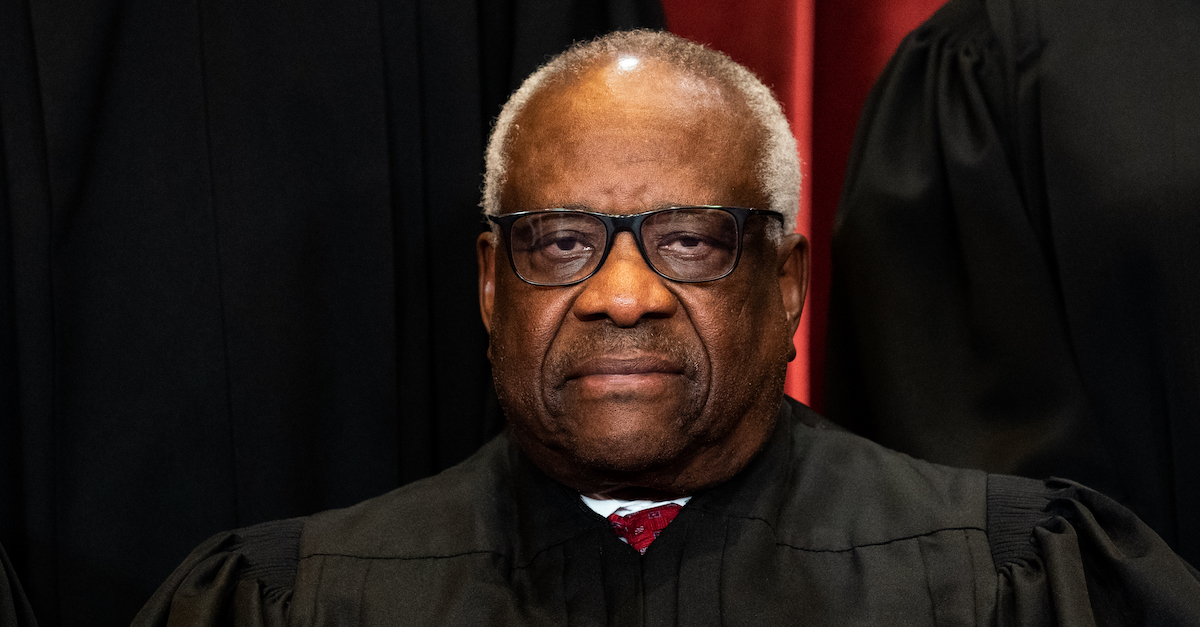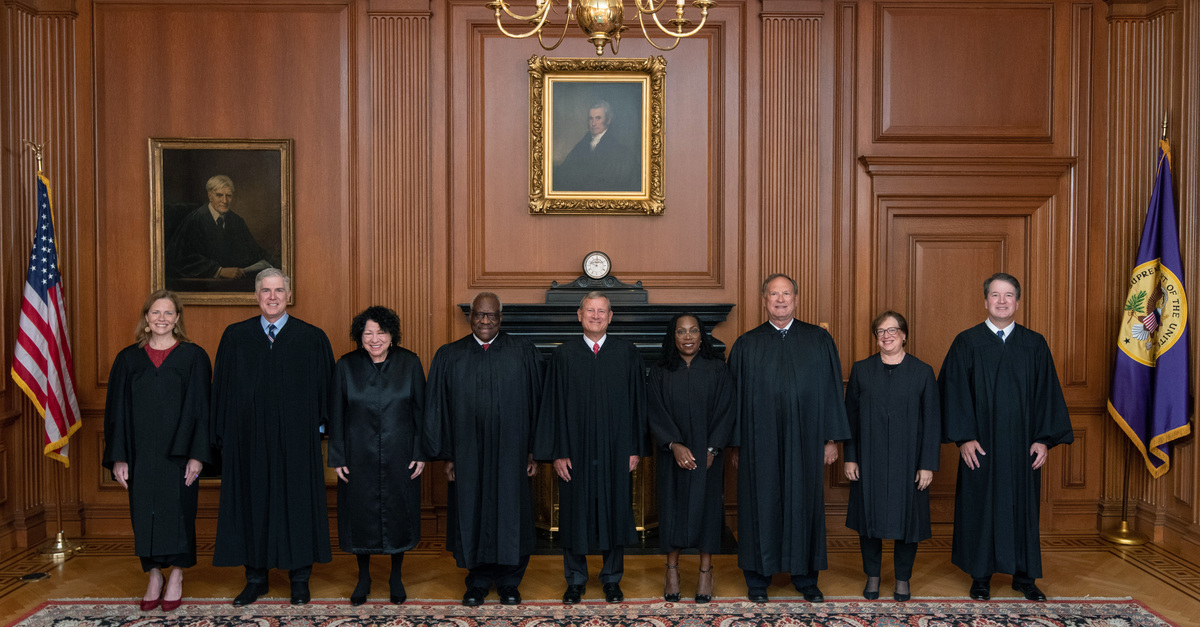
Associate Justice Clarence Thomas sits during a group photo of the Justices at the Supreme Court in Washington, D.C on April 23, 2021. (Photo by Erin Schaff/Pool/Getty Images.)
The future of affirmative action programs in the context of college admissions was before the justices Monday as Harvard and the University of North Carolina argued that their race-conscious admissions programs should be upheld.
How We Got Here
The two cases that have been consolidated for SCOTUS review involve legal challenges brought by anti-affirmative action group Students for Fair Admissions (SFFA), an organization founded by conservative legal strategist Edward Blum. SFFA hopes the cases will provide the opportunity for the Court to overrule Grutter v. Bollinger, a 2003 ruling that allows universities to consider race as an admissions factor in order to achieve campus diversity.
SFFA argues that under Brown v. Board of Education, race must not be considered at all in college admissions decisions. Further, SFFA says, the Crimson’s race-informed policies are actually hurting Asian-American applicants. SFFA claimed in its filings that “Harvard’s mistreatment of Asian American applicants is appalling” in that the school disfavors Asians on the basis Harvard believes they “lack leadership and confidence and are less likable and kind.”
U.S. District Judge Allison Burroughs (a Barack Obama appointee), however, rejected SFFA’s claim against Harvard, finding that the school’s plan, which considers race in a “flexible, non mechanical way” and relies on race only as a “plus factor,” survives strict scrutiny in its quest to prioritize general diversity.
The other case involves SFFA’s challenge to the flexible race-conscious admissions policies used by the University of North Carolina (UNC). In that case, U.S. District Judge Loretta C. Biggs (also an Obama appointee) found that UNC “produced substantial, credible, and largely uncontested evidence” that it wishes to pursue educational benefits of a diverse student body, and that those benefits are “sufficiently measurable to permit judicial scrutiny.” Biggs specifically found that UNC’s methods — which include specialized training for admissions staff to properly treat race as just one of many “plus factors” for admissions— do not violate the law.
In its brief, SFFA urges the justices to overrule Grutter, because “schools have no legitimate interest in maintaining a precise racial balance.” The group argues that the “same Fourteenth Amendment that required public schools to dismantle segregation after Brown cannot be defeated by the whims of university administrators.”
The Biden administration backs the universities, so do a group of minority students. Both argue that efforts at the university level to maintain a racially diverse student body are critical, and that the specific policies used by Harvard and UNC are appropriate. However, advocacy groups are divided over the issue of affirmative action, and nearly 100 groups, states, and politicians have filed amicus briefs in the case.
One conservative group, the National Center for Public Policy Research’s Project 21, filed an amicus brief supporting SFFA’s position and arguing that affirmative action is divisive and harmful. Project 21 chair Chairman Horace Cooper said in an emailed statement Monday, “Instead of giving a boost to the children of upper-class blacks, schools should adopt strategies that focus on helping the underprivileged regardless of race.” Others argue that race-based classifications undermine the central purpose of the 14th Amendment and that affirmative action programs are counterproductive in the world of college admissions.
The Justices Had Questions
The Supreme Court’s newest justice, Ketanji Brown Jackson, said during her confirmation hearings that she planned to recuse herself from the case that involves her two-time alma mater, Harvard. Chief Justice John Roberts is also a two-time Harvard graduate. Justices Elena Kagan and Neil Gorsuch are Harvard Law graduates, while Justices Samuel Alito, Brett Kavanaugh, Sonia Sotomayor, and Clarence Thomas all attended Yale Law School.
During Monday’s oral arguments, the justices tossed around many questions about the value of diversity generally, the effectiveness of college affirmative action programs, and at times, the role of race in a person’s identity.

In this handout provided by the Collection of the Supreme Court of the United States, Members of the Supreme Court (L-R) Associate Justices Amy Coney Barrett, Neil M. Gorsuch, Sonia Sotomayor, and Clarence Thomas, Chief Justice John G. Roberts, Jr., and Associate Justices Ketanji Brown Jackson, Samuel A. Alito, Jr., Elena Kagan, and Brett M. Kavanaugh pose on September 30, 2022 in Washington, DC.(Photo by Collection of the Supreme Court of the United States via Getty Images)
Justice Sotomayor told Patrick Strawbridge, attorney for SFFA, “Sometimes race does correlate to some experiences and not others.” She continued, “If you’re Black, you’re more likely to be in an under-resourced school, you’re more likely to be taught by teachers who are not as qualified as others, you’re more likely to be viewed as having less academic potential.”
Sotmayor allowed that these things might have only a correlation and not a causal relationship, and asked, “How do you tease that out?”
Justice Jackson raised the issue of SFFA’s standing several times during arguments. Jackson pressed Strawbridge on what particular injury members of his organization actually suffered that might give them standing. When Strawbridge answered that unfair competition for admission constitutes cognizable injury, Jackson commented, “I’m worried you’re asking us for a special standing rule.”
Chief Justice Roberts asked several times whether UNC could use “race-neutral alternatives” in its admissions policies and offered the example of an Asian American applicant.
Justice Kagan raised the question of the role of campus diversity in broader society. Kagan asked Strawbridge to imagine a “precipitous decline” in the number of minorities admitted to a school.
Kagan characterized SFFA’s argument as saying “it doesn’t matter if minority enrollment falls through the floor.”
Kagan, responding to the claim that racial diversity in education doesn’t matter: “I thought that part of what it meant to be an American and to believe in American pluralism is that, actually, our institutions are reflective of who we are as a people in all our variety.” pic.twitter.com/kkT1JUFfYH
— Mark Joseph Stern (@mjs_DC) October 31, 2022
Kagan then offered a lengthy statement on campus diversity:
Your brief says it just doesn’t matter if our universities look like America. I’m asking you — doesn’t it? These are the pipelines to ledership in our society. It might be military leadership, it might be business leadership, it might be leadership in the law… Universities are the pipeline to that leadership. If universities aren’t diverse, and your rule suggests that it doesn’t matter, well then, all of those institutions aren’t going to be racially diverse either
Kagan also raised a hypothetical in which men might benefit from affirmative action programs at the collegiate level. Noting the wealth of statistical evidence that colleges get more qualified women than qualified men in their applicant pool, Kagan hypothesized about a situation in which student bodies became overwhelmingly female.
When Strawbridge suggested that a university might consider gender to keep enrollment balanced, Kagan asked incredulously, “White men get the thumb on the scale, but people who have been kicked in the teeth by our society for centuries do not?” Strawbridge clarified that that men might, though any consideration of whiteness would be unconstitutional.
Justice Gorsuch continued to build on Kagan’s hypothetical and commented that under the VMI case, gender is an “impermissible basis” for discriminating against applicants. Several times, Gorsuch also raised question about Harvard adopting its admissions standards in an effort to weed out “too many” Jewish students.
Justice Jackson also raised a separate constitutional problem that might result directly from a ruling in SFFA’s favor: refusing to take race into account might create its own equal protection violation. Jackson presented a hypothetical in which two students — one a legacy student at the university; the other a descendant of slaves who would have been historically prevented from enrolling in the university — submit college essays that detail their personal family histories. In such a situation, asked Jackson, “isn’t that an equal protection problem?”
What Is Diversity?
When Solicitor General of North Carolina Ryan Park took the podium on behalf of the UNC, Justice Thomas began the questioning with an open-ended question about the real meaning of “diversity.”
“I don’t have a clue what it means,” said Thomas, adding, “It seems to mean everything for everyone.”
A skeptical Thomas commented on his view of the purpose of college: “When a parent sends a kid to college, they don’t necessarily send them there to have fun for feel good or anything like that.”
“They send them to learn physics or chemistry or whatever they’re studying,” Thomas continued, before asking what “educational benefits” are delivered by diversity initiatives.
Later, Thomas picked up on this line of questioning again, acknowledging that he might be “tone deaf” in his views of the college selection process. When the attorneys responded with their views of the benefits of a racially diverse student body, Thomas commented, “I guess I don’t put much stock in that, because I’ve heard similar arguments for segregation.”
Justice Alito called into question a suggested subjective nature of racial identity. First, Alito hammered Park on the question of how a prospective student from the Middle East might “check the box,” asking what justification there would be to “lump together” students of Chinese descent and those of Afghani descent.
Alito went on to hypothesize about just how much heritage would be enough for a school to consider race as a “plus factor.”
“Let’s say that a student has one grandparent that falls within that class? What about one great-grandparent?” Alito offered.
Next Alito posed a hypothetical that reminded many court-watchers of Sen. Elizabeth Warren (D-MA). Alito asked about a person whose “family lore” says that “we have an ancestor that is an American Indian.” On that basis, Alito said, the person “identif[ies] as an American Indian.”
Park responded that anyone making such a claim would likely not be telling the truth, but that the school relies on self-reporting for all demographic factors.
You can listen to the full oral arguments here.
[Image via Irin Schaff/Pool/Getty Images]